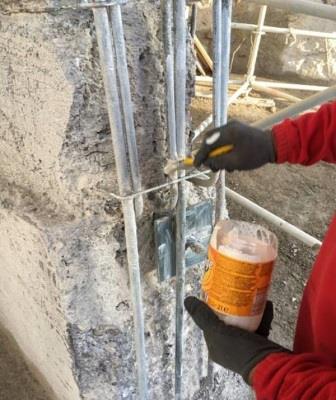A novel rust primer with migrating corrosion inhibitor technology, manufactured by corrosion control technologies group Cortec Corp. (St. Paul, Minnesota, USA), is currently being used to help preserve a historic war-destructed monument, the Vukovar Water Tower, in Vukovar, Croatia.1
Known as CorrVerter, the single-component liquid primer converts rust into a hydrophobic passive layer before coating it with a film-forming latex that is combined with thickeners and dispersant for protection against rerusting, the manufacturer explains.
Technology Details
The water-based, non-flammable product combines chelating agents with a high-solids, waterborne latex that has extremely low water vapor permeability, the company explains. The coating can be applied to rusty or poorly prepared steel surfaces where further corrosion protection is required, and where good surface preparation is difficult to achieve.

The patented corrosion inhibiting technology is designed to protect the reinforcing metal in concrete, or rebar, from corrosion. After curing, the coated rebar has equal or better bond strength to concrete, the manufacturer explains. In salt-spray testing conducted using the ASTM B117
2 standard, the primer provided over 1,000 h of corrosion protection on previously rusted steel parts.
Since overspray of the rust-converting primer on the interior concrete surface during repair operations could affect the repair mortar’s adhesion to the preexisting concrete, the primer was applied by brush to the Vukovar Water Tower.
Application Details
 According to the manufacturer, corroded surfaces of the 50.3-m (165 ft) tall Vukovar tower were left unprotected and allowed to rust for 23 years after the war ended. Finally, in late 2017, significant construction works began on the monument’s refurbishment.
After mechanically removing loose rust and scale with a wire brush, coating applicators washed the metal surfaces with water to remove excess salt contamination and dust.
According to the manufacturer, corroded surfaces of the 50.3-m (165 ft) tall Vukovar tower were left unprotected and allowed to rust for 23 years after the war ended. Finally, in late 2017, significant construction works began on the monument’s refurbishment.
After mechanically removing loose rust and scale with a wire brush, coating applicators washed the metal surfaces with water to remove excess salt contamination and dust.
From there, the rust-converting primer—which can be applied to dry or damp surfaces—was applied directly to the corroded concrete reinforcements at 3 to 5 mils (75 to 125 µm) of dry film thickness. The coating can be applied at temperatures ranging from 55 to 100 °F (13 to 38 °C), and dries within hours. After placing the primer on the concrete reinforcement, the customer then applied mortar mixed with the company's MCI-2006 corrosion inhibitor.
The rust-converting primer can be topcoated with either water-based or solvent-based topcoats. After the reinforcements are all coated with the primer, the Vukovar tower will be topcoated with the company's water-based MCI Architectural Coating.
The Vukovar project started on September 2017 and is currently slated to finish in November 2018, according to the technology provider.
Other Historic Applications
Similar corrosion inhibiting primer technologies have been used for the construction and rehabilitation of other famous buildings around the world, including the Empire State Building in New York, New York, USA; the Pentagon in Arlington, Virginia, USA; and the Burj Khalifa in Dubai, United Arab Emirates, known as the world's tallest building.
But for this manufacturer, the Vukovar water tower project takes on special significance. The Vukovar Water Tower was hit more than 600 times by artillery during the Croatian War of Independence in the 1990s.3 According to Cortec, which is donating its migrating corrosion inhibitor technology to the project, the tower was almost destroyed during the war but never collapsed.
The water tower, long seen as one of the most famous symbols of the city's suffering during the war’s Battle of Vukovar, will not be restored to its original function. Instead, it will become a memorial site, with 640 shell holes remaining untouched as a symbol of the city’s destruction and its resistance.
“This is a very emotional moment, as Vukovar is in the heart of every Croatian citizen,” says Cortec CEO Boris Miksic, a Croatian native. “We are proud to donate this technology, which will preserve Vukovar’s monument for all generations to come. This symbol of one of the most destructive wars in modern history is warning that it must never happen again.”
Source: Cortec Corp., www.cortecvci.com
References
1 “CorrVerter MCI Technology Utilized to Preserve War-Destructed Monument,” Announcements and Press Releases, Feb. 22, 2018, https://www.cortecvci.com/whats_new/announcements/Restoration-of-water-tower-22.2.pdf (June 12, 2018).
2 ASTM B117-16, “Standard Practice for Operating Salt Spray (Fog) Apparatus” (West Conshohocken, PA: ASTM, 2016).
3 “Croatian War of Independence,” Wikipedia, the free encyclopedia, https://en.wikipedia.org/wiki/Croatian_War_of_Independence (June 12, 2018).